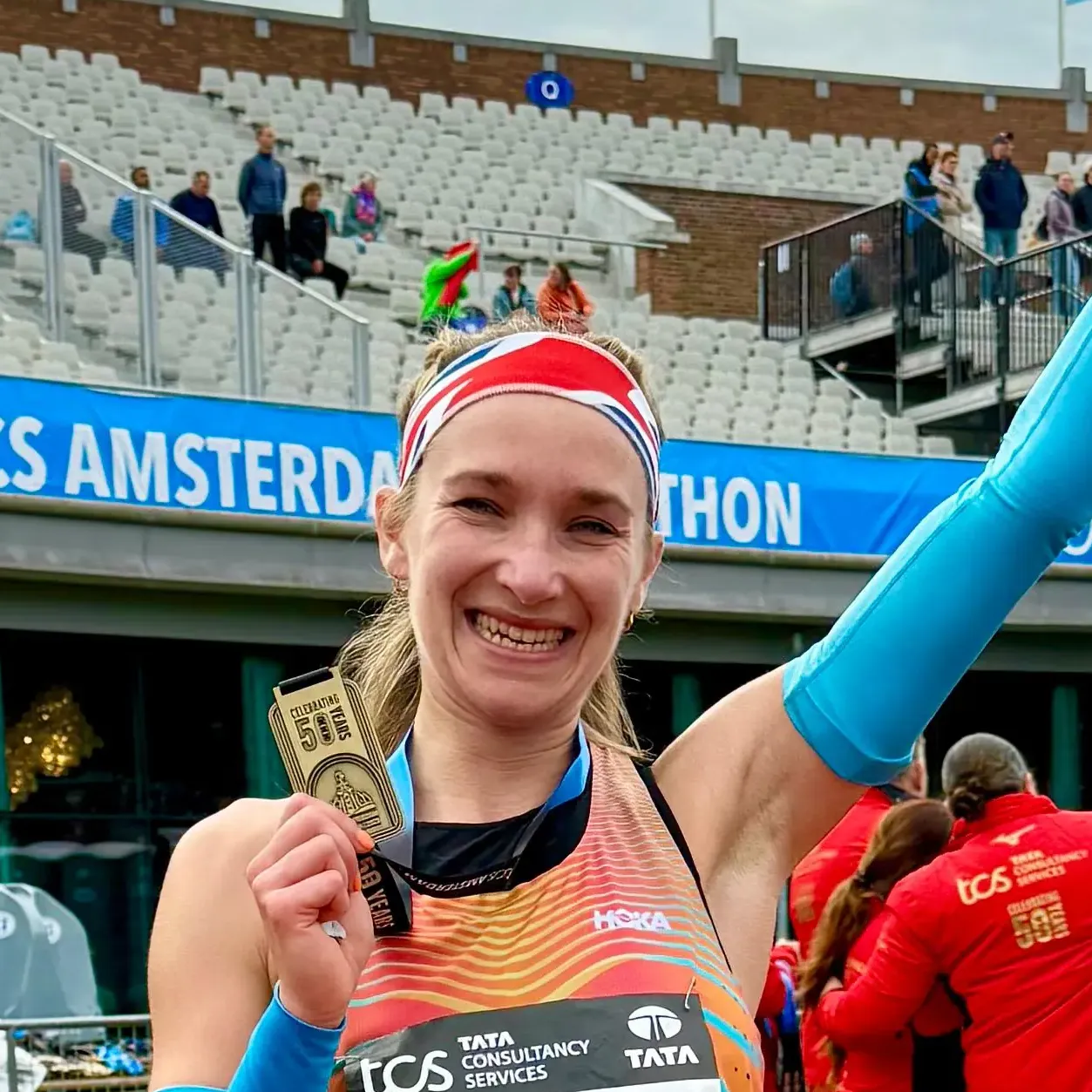
Louise Small
Amsterdam Marathon
Louise's headline numbers
Louise's strategy
Fueling
Carbohydrate is the main fuel you burn when racing. Failing to fuel properly is a leading cause of underperformance in longer races.
Louise planned to replicate the successful fueling approach she used at the 2024 Frankfurt marathon. Her strategy centred around consuming ~250ml of Carb & Electrolyte Drink Mix from bottles positioned at the elite aid stations every 5km. In preparation, she had pre-filled each bottle with ~350ml of drink mix, knowing from race simulations that she typically consumed ~250ml while running. In addition, she attached a PF 30 Gel to every second bottle with an elastic band, and From 30km onwards, she planned to switch to cola in her bottles. Together, this would allow Louise to meet her target carb intake of ~90g/h. In the lead up to the race, she practiced drinking from her marathon bottles during race-specific sessions to refine her intake and ensure the strategy was realistic and repeatable under race conditions.
On race day, Louise arrived at the first elite aid station to find that her designated bottle was missing. Thankfully, she was carrying an additional PF 30 Gel, which she took along with a small amount of a carb drink provided by another athlete. Because of this, she skipped her planned gel at 10km, but resumed her schedule at 20km. At 30km she experienced some nausea so once again didn’t use her planned gel, and relied on cola to see her across the finish line. Despite these mid-race adjustments and missing bottles, Louise executed her plan well and maintained adequate carb intake, whilst also running a new personal best - a great example of being able to execute a race plan even when things don’t go perfectly from a nutrition perspective.
Hydration
Taking on board an appropriate amount of fluid and sodium is essential to maintaining blood volume and supporting the cardiovascular effort needed to perform on race day.
Whilst the absolute amount of sodium and fluid consumed per hour is important, it’s critical to consider these in relation to each other. This is known as 'relative sodium concentration' and it’s expressed in milligrams per litre (mg/L). How much sodium you’re taking in per litre of fluid is more important than the absolute amount taken in per hour.
Sweat sodium concentration (mg/L) is largely genetically determined and remains relatively stable. Knowing how salty your sweat is enables you to replace a good proportion of your sweat losses, which can range from 200-2,000mg/L.
Whilst Louise’s losses are on the low side, getting her hydration strategy right is still important if she wants to perform at her best.
Learn moreLouise’s hydration plan centred entirely around consuming Carb & Electrolyte Drink Mix at regular intervals throughout the race. Together with the cola that she incorporated into her strategy in the final ~12km, this meant that the relative sodium concentration of her intake closely matched the sodium concentration of her sweat. Louise sometimes chooses to pick up some additional water at aid stations, but given the relatively cool conditions in Amsterdam she didn’t feel the need to. Interestingly, we are observing more and more endurance athletes using sodium bicarbonate prior to racing, and Louise has recently incorporated this into her pre-race strategy, believing it to provide some additional performance benefits. Given the high quantity of sodium in sodium bicarbonate (~270mg sodium per gram of sodium bicarb), this will also have ensured she started the race well hydrated due to the effects of sodium on fluid retention. Importantly, Louise has practiced using sodium bicarb and prefers to use this alongside her usual pre-loading strategy using PH 1500.
Caffeine
Beyond the Three Levers of Performance (carb, sodium and fluid), caffeine is one of only a few substances that is proven to improve performance for most endurance athletes as it can help stave off mental and physical fatigue.
Louise’s caffeine intake came from a PF 30 Caffeine Gel taken in the final few minutes before the race, as well as the cola in her bottles at the 30km and 35km elite aid stations. This dose is sub-optimal, given the known benefits of caffeine tend to occur with an intake of 3 to 6mg/kg of bodyweight. Incorporating 1-2 PF 30 Caffeine Gels during the race would be a small and simple adjustment to make for future races which would likely maximise the ergogenic benefits she experiences from the supplement.
How Louise hit her numbers
Here's everything that Louise ate and drank on the day...
Louise's weapons of choice
Final thoughts
Louise's full stats
Data Confidence?
There is an adequate level of accuracy in the data collected and the numbers reported. The athlete manages to recall what they ate and drank including most specifics (brands flavours quantities plausible estimations of volumes). However there are estimations made within the data which affect the overall confidence level in the data reported.